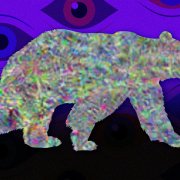Images that humans perceive as completely unrelated can be classified as the same by computational models.
Anne Trafton | MIT News
Human sensory systems are very good at recognizing objects that we see or words that we hear, even if the object is upside down or the word is spoken by a voice we’ve never heard.
Computational models known as deep neural networks can be trained to do the same thing, correctly identifying an image of a dog regardless of what color its fur is, or a word regardless of the pitch of the speaker’s voice. However, a new study from MIT neuroscientists has found that these models often also respond the same way to images or words that have no resemblance to the target.
When these neural networks were used to generate an image or a word that they responded to in the same way as a specific natural input, such as a picture of a bear, most of them generated images or sounds that were unrecognizable to human observers. This suggests that these models build up their own idiosyncratic “invariances” — meaning that they respond the same way to stimuli with very different features.
The findings offer a new way for researchers to evaluate how well these models mimic the organization of human sensory perception, says Josh McDermott, an associate professor of brain and cognitive sciences at MIT and a member of MIT’s McGovern Institute for Brain Research and Center for Brains, Minds, and Machines.
“This paper shows that you can use these models to derive unnatural signals that end up being very diagnostic of the representations in the model,” says McDermott, who is the senior author of the study. “This test should become part of a battery of tests that we as a field are using to evaluate models.”
Jenelle Feather PhD ’22, who is now a research fellow at the Flatiron Institute Center for Computational Neuroscience, is the lead author of the open-access paper, which appears today in Nature Neuroscience. Guillaume Leclerc, an MIT graduate student, and Aleksander Mądry, the Cadence Design Systems Professor of Computing at MIT, are also authors of the paper.
Different perceptions
In recent years, researchers have trained deep neural networks that can analyze millions of inputs (sounds or images) and learn common features that allow them to classify a target word or object roughly as accurately as humans do. These models are currently regarded as the leading models of biological sensory systems.
It is believed that when the human sensory system performs this kind of classification, it learns to disregard features that aren’t relevant to an object’s core identity, such as how much light is shining on it or what angle it’s being viewed from. This is known as invariance, meaning that objects are perceived to be the same even if they show differences in those less important features.
“Classically, the way that we have thought about sensory systems is that they build up invariances to all those sources of variation that different examples of the same thing can have,” Feather says. “An organism has to recognize that they're the same thing even though they show up as very different sensory signals.”
The researchers wondered if deep neural networks that are trained to perform classification tasks might develop similar invariances. To try to answer that question, they used these models to generate stimuli that produce the same kind of response within the model as an example stimulus given to the model by the researchers.
They term these stimuli “model metamers,” reviving an idea from classical perception research whereby stimuli that are indistinguishable to a system can be used to diagnose its invariances. The concept of metamers was originally developed in the study of human perception to describe colors that look identical even though they are made up of different wavelengths of light.
To their surprise, the researchers found that most of the images and sounds produced in this way looked and sounded nothing like the examples that the models were originally given. Most of the images were a jumble of random-looking pixels, and the sounds resembled unintelligible noise. When researchers showed the images to human observers, in most cases the humans did not classify the images synthesized by the models in the same category as the original target example.
“They’re really not recognizable at all by humans. They don’t look or sound natural and they don’t have interpretable features that a person could use to classify an object or word,” Feather says.
The findings suggest that the models have somehow developed their own invariances that are different from those found in human perceptual systems. This causes the models to perceive pairs of stimuli as being the same despite their being wildly different to a human...
Read the full story on the MIT News website using the link below.

